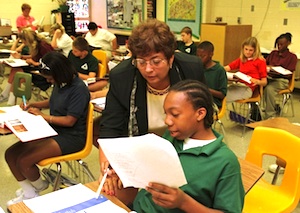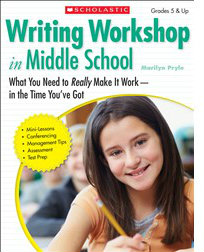Managing Multiple Writing Conferences
 by Marilyn Pryle
by Marilyn Pryle
Here, Marilyn Pryle describes her favorite conferencing technique: multiple conferences of small duration with each student, as she revolves around the classroom. In an earlier article, Marilyn discussed the importance of praise and a clear focus on meaning, not grammar, in the early stages of conferencing.
I have found multi-conferencing to be perhaps the most useful conferencing technique of the writing workshop model. It works as an umbrella over all the other techniques. Here are some of its benefits:
• It breaks down the revising process into specific, manageable parts for students.
• Students don’t feel the pressure of being watched as they work.You can visit many students during one class period.
• Your constant circulation in the class keeps students working and prevents discipline problems.
Multi-conferencing incorporates aspects of both content and duration. Simply put, multi-conferencing looks like this:

2. Move on to another student, and repeat Step 1.
3. Move on to another student, and repeat Step 1.
4. Check in. If the first student is still working, repeat Steps 2 and 3. Otherwise, check back on the first student. If the draft is ready to be handed in, direct the student to do so. If not, figure out what the draft now needs, and give the student another task or two. Move on to another student.
5. Continue your rounds. Continue visiting new students while periodically checking with students you’ve already visited.
The key to efficient multi-conferencing is that you give students small, manageable tasks that they can do on their own. They don’t need you to sit there, which frees you up to see more students. In this way, class time becomes a chain of productivity.
What is a small, meaningful, concrete task?
Depending on what a draft needs, a small task can range from making lists of sensory details to getting a pair of scissors and cutting all the draft paragraphs apart and rearranging them like a puzzle. The task is directed and specific. You wouldn’t say, “Your conclusion needs work,” and walk away. Instead, you would say, “Think of three possible solutions to the problem you present in your thesis. Write each one down.”
Examples of Small, Concrete Tasks
Here are some examples of small, concrete tasks, although really the possibilities are endless:
• List the five senses on the student’s paper and tell him or her to write three details about the setting under each sense.
• With the student, identify his or her essay’s three main ideas and then color-code those ideas with different-colored highlighters. Then have the student highlight each sentence in the coordinating color. (A rainbow will indicate a lack of organization!) When you return, help the student reorganize the essay.
• Review what a linking verb is and have the student underline all the linking verbs in his or her paper. When you return to check with the student, have him or her change six of those linking verbs to action verbs.

• Have the student list the three most important ideas or moments from his or her paper. When you return, underline any words from this list that you find powerful. Then direct the student to write two possible titles using some of the words you underlined.
• Underline any repeated mistake regarding a certain convention. Explain the convention to the student and leave him or her to fix all the underlined words independently.
Notice that these suggestions involve a specific number, or underlining, or choosing (from a poster or the student’s own list). This is what makes the tasks concrete and manageable. I don’t just say to a student, “Put in more sensory details.” I write the five senses on the paper and tell him or her to list three details under each. That writer may not use all 15 details, but he or she will have plenty to choose from.
Likewise, I don’t simply instruct a student to “Show, don’t tell” and leave him or her to figure out what that means. I don’t say “Add transition words” without indicating where and giving transition words to choose from.
Tips for Giving Small, Concrete Tasks
Here are some general tips for devising small, concrete tasks during conferences:
• If possible, put a number on a task. This gives the student an end goal.
• Try to limit each visit to one topic (details, linking verbs, transition words, and so on). This keeps the student focused and prevents him or her from becoming overwhelmed. If there are no larger or repeated issues to address, combine no more than two small topics.
• Make categories for the student to create lists under (five senses, pros/cons, three statistics).
• Involve other resources: posters, different-colored pens or highlighters, scissors, other books, and so on. (I once had a student read the first line of every short story in her English anthology and create categories of first-line techniques.)
• If possible, set up choices for the student. For example, have him or her list ten sensory details and then choose seven. Or, have the student write out two possible attention-grabbers (e.g., a statement of general truth, and a statistic) and let him or her choose the favorite.
______
Marilyn Pryle is a middle grades language arts teacher who lives in Pennsylvania. She is the author of several professional books from Scholastic: Teaching Students to Write Effective Essays; Purposeful Conferences—Powerful Writing!; and Easy & Effective Writing Lessons for English Language Learners. This article is adapted from Marilyn’s latest book, Writing Workshop in Middle School (2013), reviewed here. Follow her on Twitter @mpryle.

































